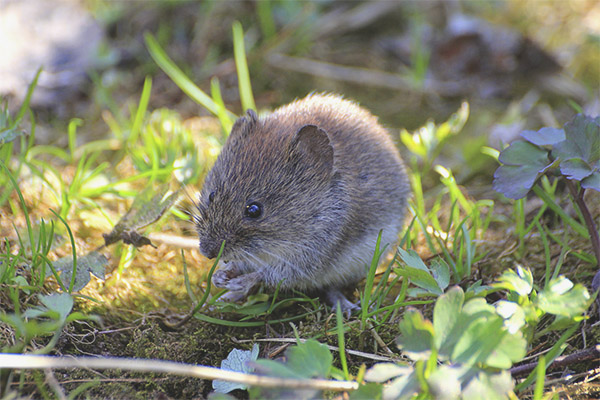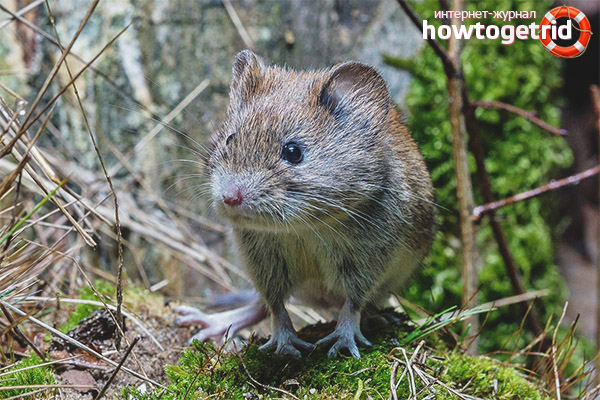The content of the article
The forest vole is a small rodent from the subfamily of the voles. Small body size and color make them look like mice. They are an important part of the food chain, as they enter the diet of many predatory animals.
General description of the appearance
The forest vole has a rounded body 8-10 cm long, with a tail length of 3-6 cm. The eyes and auricles are small and hidden among thick wool. The color of the skin on the back has a rusty hue, while the belly is colored in light colors. In the cold season, the animals overgrow with a thick layer of brown wool. Most species of voles do not have molar roots, but forest voles have them.
Like other rodents, sensitive whiskers (vibrissae) grow on the muzzle of voles, which help them to perceive environmental changes and orient themselves in space.Paws are tenacious and have 4 fingers. The tail of the voles is covered with short hair, so it looks thin relative to the body.
Lifestyle and nutrition
Forest voles inhabit a vast territory of North America and Eurasia. As the name implies, for the settlement, animals prefer forests, both deciduous and coniferous. Voles live under fairly diverse climatic conditions, occurring in the forest tundra and in the mountains at an altitude of 3000 m.
A forest vole is chosen outside at dusk when it is hardest to detect. She quickly climbs and runs, and at the slightest threat the animal hides in the nearest thicket.
Despite an active lifestyle, voles are cautious and behave very secretively in the presence of larger animals.They make their homes in burrows dug in the forest floor or moss. Also, they serve as shelter shrubs and tree roots. The voles learned to climb the trunks and low branches well. Some individuals even live in empty hollows and bird nests.
Despite the ability to dig holes, voles do it with reluctance, often preferring to occupy the existing holes and holes in the ground. From the inhabited hole near the voles, several permanent routes to places of feeding were laid. In winter, these routes turn into tunnels under a layer of snow. To dig a snowdrift, the vole makes quick movements with its paws and head from side to side.
The basis of nutrition is vegetable food. Unlike many other rodents, they do not eat insects. In summer, in addition to grass and lichen, voles eat mushrooms and berries. Under harsh winter conditions, animals supplement their diets with bark of shrubs and young trees. For the winter, they make huge stocks of seeds, the weight of which can reach half a kilogram per animal.
A favorite delicacy of voles are the diverse seeds of herbaceous plants, as well as acorns.If the animal has not eaten a nut, then it reliably digs in it and remembers the place of the treasure. Vole can go back there and pick up the left acorn.
Active reproduction
The animals prefer to live in solitude, joining together in pairs for the time of cold weather and during mating. During the period of pregnancy and reproduction, females behave aggressively towards their relatives who have penetrated into its territory.
The forest voles have many natural enemies who would have destroyed this species long ago, if not for the unique ability of rodents to breed. During the year, the female gives birth 4 times, producing up to 40 cubs during this time. Pregnancy lasts only 20 days. The young appear blind and hairless, their weight is only 1-10 g. On the 12th day they open their eyes, and two days later they first leave the hole. By the end of the first month of life, forest voles are ready to lead independent lives and to participate in breeding.
Despite such rates of reproduction, voles did not overpower the forests for one simple reason: their life expectancy is a year and a half. Under laboratory conditions, this indicator is somewhat higher, since wild voles perish prematurely due to predators.But this does not negate the fact that their organism has a high rate of aging, and within a year and a half the forest voles go through the main life stages.
Preservation of the form
Due to active reproduction and the ability to adapt to environmental conditions, voles are a numerous species and are not on the verge of extinction. The greatest density of the number of animals reaches in the deciduous forests of Europe.
Captivity
Forest voles attract many people with their appearance, so it is not surprising that these animals are often kept in an apartment as pets. Voles tolerate domestic content and do not show aggression towards people. The animals are easily tamed, and soon they can be ironed and even planted on the palm. However, it must be ensured that the vole does not run away.It is able to penetrate into the hard-to-reach gap, and getting it back will be a great difficulty.
For feeding the forest vole at home, you can use a variety of seeds and grains, nuts. Although rodent does not eat meat in nature, it will not give up a few cooked pieces of chicken. Teeth voles grow all their life, and they need to grind. Therefore, it is important to ensure that the diet of the animal was enough solid food.
Video: forest vole (Clethrionomys)












To send